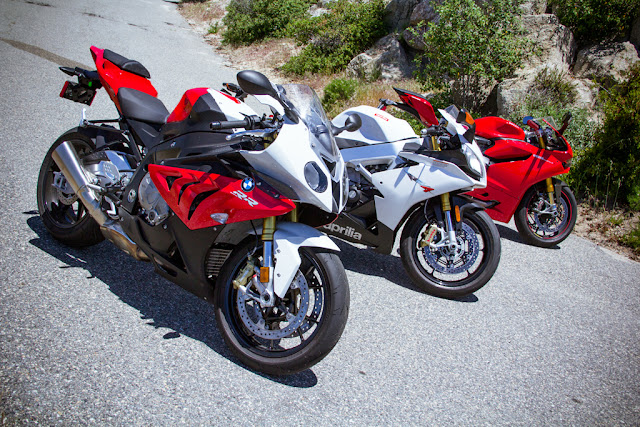APRILIA RSV4 R APRC,BMW S1000 AND DUCATI 1199
APRILIA RSV4 R APRC,BMW S1000 AND DUCATI 1199.We teased you with a sneak peak of our track impressions after riding the 2012 Aprilia RSV4 R APRC, BMW S1000RR and Ducati 1199 Panigale S at the fast and undulating Thunderhill Raceway with our friends at Keigwins at the Track. We were genuinely impressed with all three machines, and our purely subjective ratings continually changed during the course of the day. Now, however, we’ve had a chance to ride our protagonists on the streets and highways, get dyno numbers, collect our thoughts and tabulate scores on the trusty MO scorecard.
As mentioned in our track teaser, we’re missing a couple of bikes for a full-sledged Euro literbike shootout. We thought we had secured an F4 1000 R from MV Agusta, but then, mysteriously, they stopped returning our emails – coincidentally after their Brutale R 1090 lost our Litertbike Streetfighter Shootout. And it would’ve been interesting to see how KTM’s V-Twin RC8 could compete with the Panigale, but they were unable to get us a bike during our testing window. We should also take a moment to explain why we’re using a Panigale S instead of the standard 1199. Simply put, Ducati couldn’t supply non-S Panigales until next month, and we couldn’t wait!
After wringing out our trio on the track, it didn’t take a dyno to figure out which machine made the most power. Our seat-of-the-pants dyno quickly registered the S1000RR as the horsepower king in this lot, followed by the Ducati and Aprilia. The BMW spun the DynoJet dyno operated by Hypercycle owner and former Nicky Hayden crew chief, Carry Andrew, to the tune of 172.5 hp. The highly-oversquare Superquadro engine of the 1199 made 162.1 hp, and the Aprilia brings up the rear with “just” 156.9 ponies.
Impressive, but we expected the BMW and Ducati to pump out more. Our 2011 S1000RR made a ridiculous 185.8 horses, and Ducati’s press materials tout the Panigale’s peak output as 195 hp rated at the crank, with company officials claiming mid-170s at the wheel. Nonetheless, these are still strong numbers taken on the same day, on the same dyno, even following Ducati’s detailed instructions for dynoing the Panigale.
Ducati’s four-page instruction guide on proper dyno preparation and procedure involves various steps, most important of which is disconnecting the rear wheel-speed sensor. The 1199’s ECU uses this sensor to “estimate the boost effect present in the air ducts at high speed” via ram air. With the sensor connected and the rear wheel spinning at a high rate, the ECU thinks the ram-air effect is high and reacts by sending an overly rich fuel mixture to the cylinders to compensate, thus giving a false reading. Disconnecting the sensor delivers an appropriate air/fuel ratio while the bike is stationary on the dyno. Handy tip for those looking to dyno their own Panigale: obtain (or have your dealer provide) these instructions when buying.
